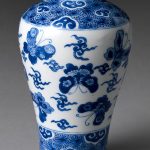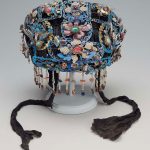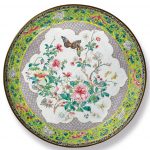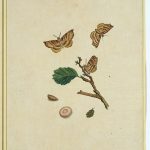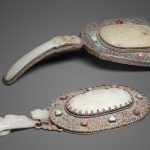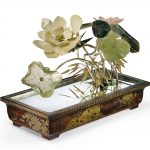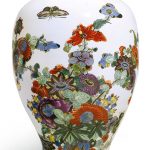The Qing dynasty, officially the Great Qing , was the last imperial dynasty of China. It was established in 1636, and ruled China proper from 1644 to 1911. It was preceded by the Ming dynasty and succeeded by the Republic of China. The Qing multi-cultural empire lasted for almost three centuries and formed the territorial base for modern China. It was the fifth largest empire in world history. The dynasty was founded by the Manchu Aisin Gioro clan in Manchuria. In the late sixteenth century, Nurhaci, originally a Ming vassal, began organizing “Banners”, military-social units that included Manchu, Han, and Mongol elements. Nurhaci united Manchu clans and officially proclaimed the Later Jin dynasty in 1616. His son Hong Taiji began driving Ming forces out of the Liaodong Peninsula and declared a new dynasty, the Qing, in 1636. Reference: Wikipedia
Below are some examples, information and price guides to antiques depicting butterflies from the Qing dynasty, including a woman’s headdress and a jade planter.
Vase with Butterflies late 17th–early 18th century China The Chinese term for butterfly (hudie) is also a rebus for the accumulation of blessings.
Qing dynasty (1644–1911), Kangxi period (1662–1722)
Reference: The Metropolitan Museum of Art
Woman’s headdress (tien tzu)
Phoenix crown Chinese Qing dynasty 19th century
The Eurasian kingfisher is known for its radiant, iridescent feathers of electric blue. In China, the plumes, known as fei-ts’ui, are highly prized and were used as early as the Han dynasty (206 B.C. – A.D. 220) to decorate wall hangings and bedcovers. During the Ming (1368-1644) and Qing (1644-1912) dynasties, the feathers were also used in jewelry and headdresses, especially those worn by noblewomen on ceremonial occasions and brides on their wedding day. By the early twentieth century, small ornaments incorporating fei-ts’ui were popular among ladies of lesser rank. As a result, it was not long before demand outstripped supply for these exotic feathers and the bird became extinct in China.
This headdress, characterized by a curved front and flat crown, would have been worn by a lady of considerable wealth. It was made on a latticework armature of iron wire covered by a black silk satin. Attached to the fabric are numerous decorative motifs, including a central blossom with a jadeite center and pink tourmaline petals; butterflies; bats; flowers; and two phoenixes amid stylized waves and clouds. These are embellished by kingfisher feathers set in gilt metal mounts, pearls, and semi-precious stones. Many of the flowers and critters are en tremblant, that is, they are attached by coiled metal strips to the armature and would have quivered when the wearer moved about, thus creating a shimmering effect. A pearl strand fringe with decorative beads and colorful glass pendants frames the front of the headdress.
A PAINTED CANTON ENAMEL ‘FLOWERS AND BUTTERFLIES’ DISH QING DYNASTY, 18TH CENTURY finely enameled, centering a white lobed floriform medallion enclosing two butterflies above leafy floral stems including peony, peach, magnolia, and aster against a lilac diaper ground, the cavetto with a yellow floral and bats scroll, a navy foliate band at the rim, the exterior and base enameled yellow, the sides with further floral scroll, the base with a coiled dragon roundel surrounded by four dragons in profile, a blue keyfret band encircling the footring Diameter 10 1/8 in., 26.3 cm
Sold for 11,250 USD at Sotheby’s in 2019
This painting shows two brown butterflies. Exotic flora and fauna were of great interest to British botanists in the 18th and 19th centuries, and such enthusiasm gradually filtered down to the general public. Travellers often returned to Britain with specimens of foreign insects and, more commonly, paintings depicting those insects.
Exotic flora and fauna had strong appeal to British botanists in the 18th/19th century, and such interest gradually filtered down to the general public. Travellers brought back to Britain specimens of foreign insects and more commonly, paintings depicting those insects. This painting showing two brown butterflies was produced for such a purpose.
Reference: © Victoria and Albert Museum
Two jade-mounted metal hand mirrors Late Qing/Republic period The first of oval shape mounted with an oval jade plaque carved in delicate raised relief with a butterfly hovering over a melon vine, the metal frame chased with attributes of the Eight Immortals separated by jadeite and hardstone cabochons, the handle made from a jade belt hook with dragon decoration (minor chips to both); the second of shield shape mounted with an oval jade plaque showing a ribbon-tied endless knot, conch shell and canopy, the polychrome enameled metal frame showing jade and hardstone cabochons, the curving handle mounted with a conforming jade hairpin (chips, hairpin and handle repaired). 10 and 9 3/4in (25.4 and 24.8cm) length of mirrors (2)
Sold for US$ 6,325 (£ 4,863) inc. premium at Bonham’s in 2019
RARE PLANTER IN JADE, CORAL AND HARD STONES CHINA, XIXEME-XXEME CENTURY The quadrangular wooden planter is finely carved with birds in branches in a rocky garden on the sides and bears a poetic inscription signed Yi Gui with a stamp. The interior is decorated with stems covered with golden silk ropes holding blooming lotus flowers in their foliage, a butterfly with outstretched wings delicately resting on a stem. Dimensions of the planter: 46.3 x 22.5 cm. (18 ¼ x 8 7/8 in.) Total height: 33 cm. (13 in.)
Sold for EUR 22,500 at Christie’s in 2019

